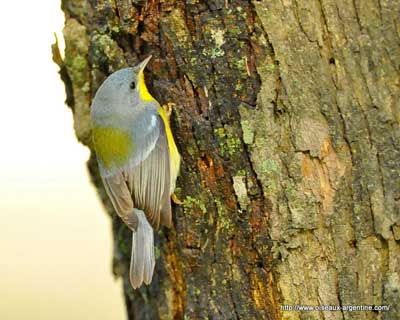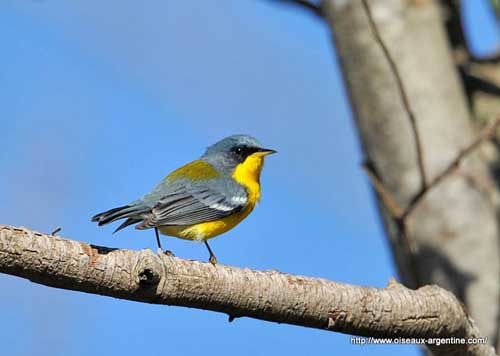
Fr: Paruline à joues noires
All : Elfenwaldsänger
Esp : Párula Tropical
Ital: Parula tropicale
Nd: Tropische Parula
Sd: Tropisk messångare
Port : Mariquita
Photographers:
Marc Chrétien
MURINUS
Philippe et Aline Wolfer
GALERIE
Text by Nicole Bouglouan
Sources:
A GUIDE TO THE BIRDS OF MEXICO AND NORTHERN CENTRAL AMERICA by Steve N. G. Howell, Sophie Webb - Oxford University Press - ISBN: 0198540124
A GUIDE TO THE BIRDS OF COLOMBIA by Steven L. Hilty and William L. Brown - Princeton University Press – ISBN 069108372X
HANDBOOK OF THE BIRDS OF THE WORLD Vol 15 by Josep del Hoyo-Andrew Elliot-David Christie - Lynx Edicions –
ISBN: 9788496553682
BirdLife International (BirdLife International)
What Bird-The ultimate Bird Guide (Mitchell Waite)
Wikipedia, the free encyclopaedia
Tropical Parula
Setophaga pitiayumi
Passeriforme Order – Parulidae Family
BIOMETRICS:
Length: 11 cm
Weight: 5-8 g
DESCRIPTION:
The Tropical Parula is a New World warbler, resident in the wide range where this species is common and widespread.
The adult male has blue-grey upperparts and head. The mantle exhibits a triangular bronze-olive patch. On the upperwing, two white wing-bards are formed by the white-tipped greater and median coverts. The tail shows white patches on the three outermost rectrices.
The underparts are bright yellow, with orange wash on throat and upper breast. The undertail-coverts are white.
On the blue-grey head, the male has black lores and ear-coverts. Chin and throat are bright yellow. The bill has blackish upper mandible with black culmen, and yellow lower mandible. The eyes are dark brown. Legs and feet are yellowish-brown.

The female is slightly duller. She has grey lores and ear-coverts (not black), and very faint orange wash on throat and upper breast.
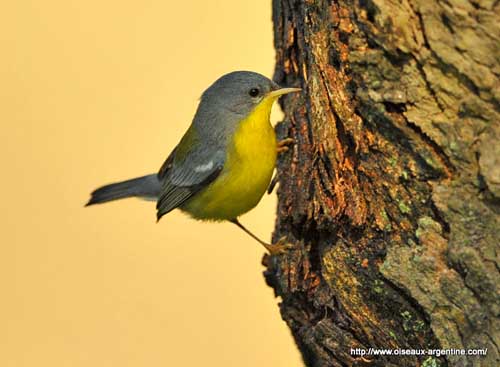
The juvenile has dull grey head and upperparts, indistinct white wing-bars and the underparts are yellowish-white with greyish tinge on flanks.
There are several subspecies, (14) which differ in body size, brighter or duller plumage and size of mantle patch.
VOICE: SOUNDS BY XENO-CANTO
The Tropical Parula’s usual call is a sharp, thin “tsit”. When the bird is alarmed, this note is repeated rapidly.
The song is an accelerating buzzy trill uttered at various pitches, often preceded by high, thin notes, sometimes compared to insect-like buzzing “tsee tsee tsee zeeeeeeeeeeeerrrip”.
The songs may vary throughout the range according to the race, and they often sing persistently.
HABITAT:
The Tropical Parula is a forest species, frequenting various forest types such as deciduous, gallery, humid submontane and lower montane forests. It is also found in second growth, edges and clearings, and scrub in Chaco. In W Mexico, it frequents the mangroves.
This species occurs from lowland up to 2500 metres of elevation.
It usually nests in clumps of epiphytes, usually Spanish moss of Bromeliaceous.
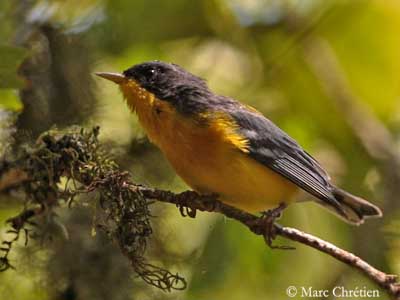
RANGE:
The Tropical Parula is resident from S Texas and NW Mexico, Central America to N Argentina, N Venezuela, Trinidad and Tobago, and NW Colombia to NW Peru, Suriname, French Guiana and N Brazil.
It is absent from most of the Amazon Basin.
BEHAVIOUR:
The Tropical Parula forages by gleaning in the outer branches of the canopy. It hovers to pick invertebrates from the leaves, and often perches upside down to reach the preys. It searches into bark crevices and vegetation, and perform sallies to hawk insects in the air.
This species feeds on insects and various invertebrates, and also takes berries.
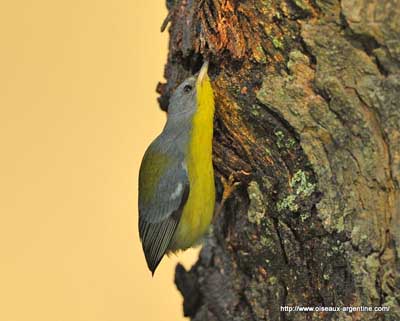

This warbler is seen in pairs or in small groups, sometimes up to 20 birds. These groups often join mixed-species foraging flocks.
The members of a pair tend to remain together all year round, on or near the territory. The courtship displays are unknown, but considering the plumage pattern of this warbler, the male probably displays the white spots of the outer rectrices by fanning its tail, and enhances the triangular mantle patch and the bright yellow underparts. Songs are uttered persistently, as well in courtship as in territory defence.
This species is mainly resident but the northernmost populations of the highlands of Mexico may winter at lower elevation.
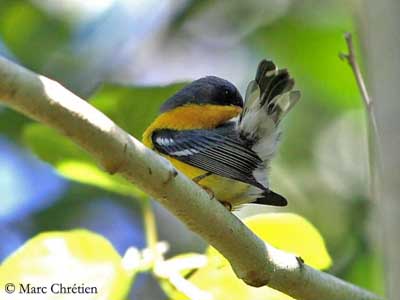
FLIGHT:
The Tropical Parula performs weak fluttering flight with shallow wing-beats.
REPRODUCTION:
The breeding season varies according to the range.
The Tropical Parula nests in wooded areas near water. They are monogamous and solitary nesters. The nest is dome-shaped with a side-entrance. It is made with mosses, pieces of bark, fine grasses, hair and feathers. This nest is placed between 3 and 13 metres above the ground, in clump of Spanish moss in tree. Spider webs can be added.
The female lays 2 creamy-white eggs finely spotted brown at large end. In Texas and N Mexico, the clutch often contains up to 4 eggs. Incubation, mainly by female, lasts about 12-14 days. The male feeds her during this period. The young fledge 10-12 days after hatching, and still depend on parents for three weeks more.

DIET:
The Tropical Parula feeds primarily on invertebrates such as insects and spiders. It may occasionally consume some berries and nectar from flowers.
It gleans in the canopy on the outer branches, and hovers to pick insects from the vegetation.
PROTECTION / THREATS / STATUS:
The Tropical Parula is common to fairly common in its range. Some populations, especially in Texas, have declined recently and the species is now rare in this region.
However, the species is not threatened.
